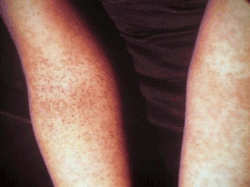Tourniquet test
- For Tourniquet, see that article

A tourniquet test (also known as a Rumpel-Leede Capillary-Fragility Test or simply a capillary fragility test) determines capillary fragility. It is a clinical diagnostic method to determine a patient's haemorrhagic tendency. It assesses fragility of capillary walls and is used to identify thrombocytopenia (a reduced platelet count).
The test is defined by the WHO as one of the necessary requisites for diagnosis of Dengue fever. A blood pressure cuff is applied and inflated to a point between the systolic and diastolic blood pressures for five minutes. The test is positive if there are 10 or more petechiae per square inch. In DHF the test usually gives a definite positive result with 20 petechiae or more.[1]
This test does not have high specificity. Interfering factors with this test are women who are premenstrual, postmenstrual and not taking hormones, or those with sun damaged skin, since all will have increased capillary fragility.[2]
Reliability
At least one insurance company, Aetna, has determined that the Rumpel-Leede test is obsolete or unreliable and has been replaced by more advanced procedures.[3]
The test remains an essential part of the assessment of a patient who may have dengue haemorrhagic fever.
References
- ^ http://www.searo.who.int/LinkFiles/Regional_Guidelines_on_Dengue_DHF_prevention_&_control_searo-29.pdf
- ^ Pagana, & Pagana, 1998; Tsai, 2000
- ^ Aetna Clinical Policy Bulletin: Obsolete and Unreliable Tests and Procedures
